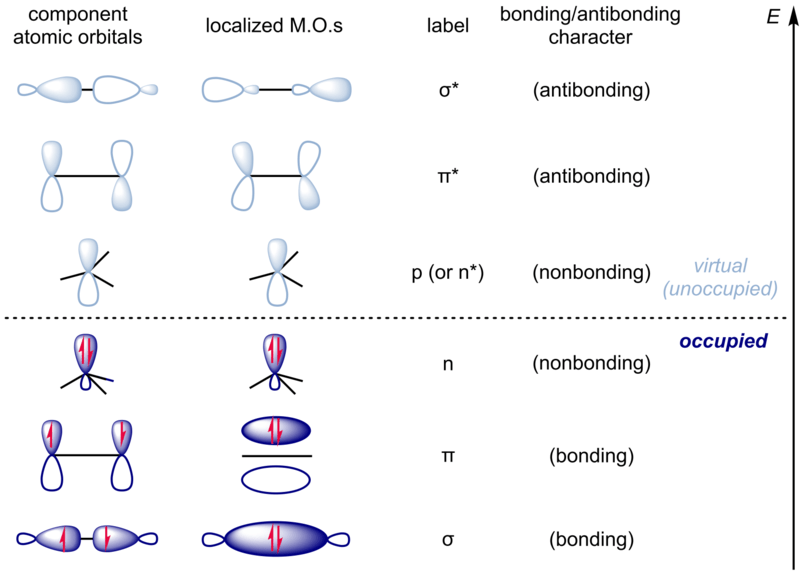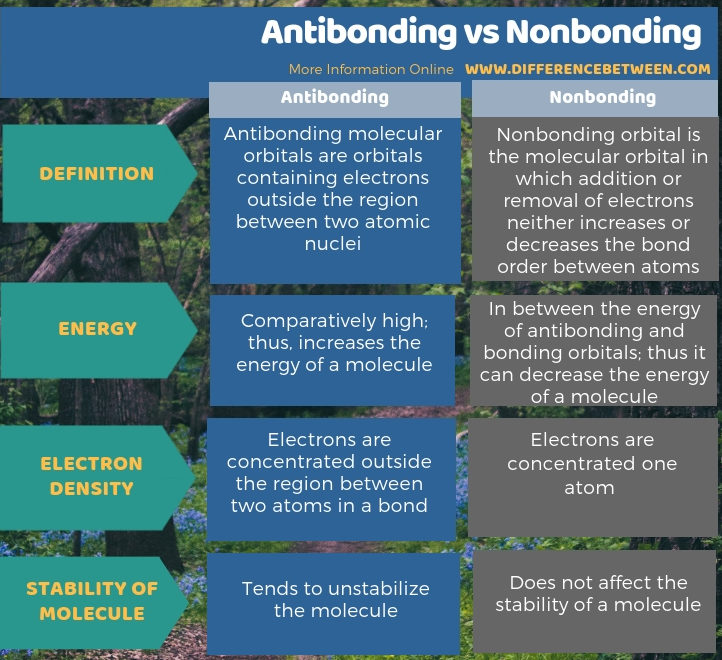Difference Between Antibonding and Nonbonding
Table of Contents
The key difference between antibonding and nonbonding is that antibonding orbitals increase the energy of a molecule whereas nonbonding orbitals do not change the energy of a molecule.
The terms antibonding and nonbonding come under the molecular orbital theory. According to this theory, these orbitals are hybrid orbitals that form due to the overlap of other orbitals.
CONTENTS
1. Overview and Key Difference
2. What is Antibonding
3. What is Nonbonding
4. Side by Side Comparison – Antibonding vs Nonbonding in Tabular Form
5. Summary
What is Antibonding?
Antibonding molecular orbitals are orbitals containing electrons outside the region between two atomic nuclei. Electrons in the antibonding orbitals reduce the stability of a molecule since these electrons spend most of their time outside the atomic nuclei. Therefore, the electron density of the antibonding molecular orbitals is less compared to bonding molecular orbitals, and antibonding molecular orbitals indicate the electron density outside the bond.
Antibonding molecular orbitals have higher energy than that of atomic orbitals and bonding molecular orbitals. This is because the electrons in these orbitals do not contribute to the reduction of repulsion between two atomic nuclei. Therefore, the stability of compounds having electrons in the antibonding molecular orbitals is lower. However, in stable compounds, the presence of electrons in antibonding molecular orbitals is no or less. Moreover, the spatial arrangement of antibonding molecular orbitals does not determine the shape or the geometry of a molecule.

According to the above image, the electron density in bonding molecular orbital is equal to that of the antibonding molecular orbital. Therefore, it is a very unstable molecule. Hence, He2 molecule does not exist. The antibonding molecular orbital is given as σ*.
What is Nonbonding?
Nonbonding orbital is the molecular orbital in which addition or removal of electrons neither increases or decreases the bond order between atoms. We often designate this orbital by “n”. These orbitals resemble the lone electron pairs in Lewis structures.
Furthermore, the energy of a nonbonding orbital is between antibonding orbital energy and bonding orbital.
What is the Difference Between Antibonding and Nonbonding?
Antibonding and nonbonding orbitals are molecular orbitals. The key difference between antibonding and nonbonding is that antibonding orbitals increase the energy of a molecule whereas nonbonding orbitals do not change the energy of a molecule. Furthermore, the presence of antibonding orbitals tends to unstabilize the molecule while nonbonding orbitals have no effect on the stability of the molecule.

Summary – Antibonding vs Nonbonding
Antibonding and nonbonding orbitals are molecular orbitals. The key difference between antibonding and nonbonding is that antibonding orbitals increase the energy of a molecule whereas nonbonding orbitals do not change the energy of a molecule.
Reference:
1. Helmenstine, Anne Marie. “Antibonding Orbital Definition.” ThoughtCo, Jul. 3, 2019, Available here.
Image Courtesy:
1. “Localized MOs” By Alsosaid1987 – Own work (CC BY-SA 4.0) via Commons Wikimedia
2. “Cartoon localized molecular orbitals” By Alsosaid1987 – Own work (CC BY-SA 4.0) via Commons Wikimedia
ncG1vNJzZmivp6x7pbXFn5yrnZ6YsqOx07CcnqZemLyue8OinZ%2Bdopq7pLGMm5ytr5Wau26tza2gm6eembavs4yapZ1lnqS7o7vNnaCnn18%3D